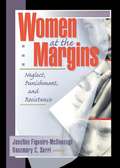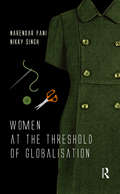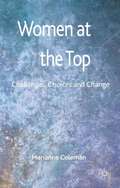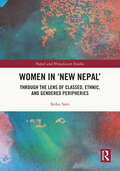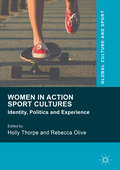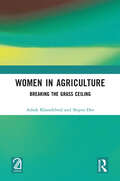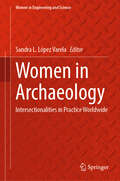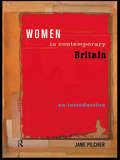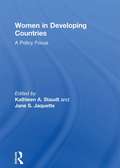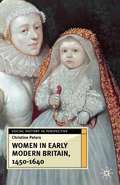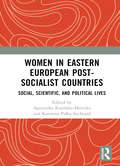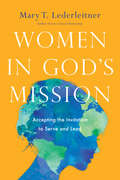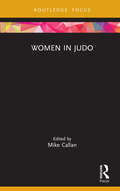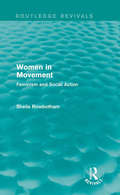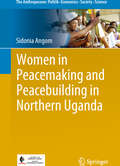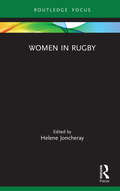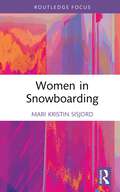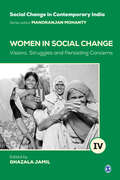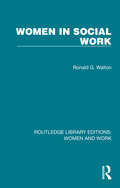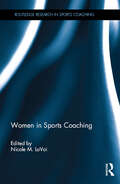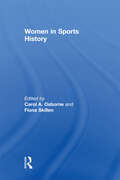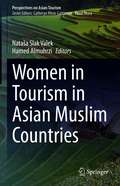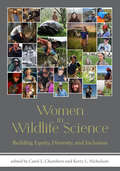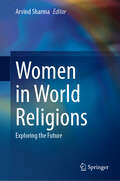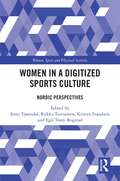- Table View
- List View
Women at the Margins: Neglect, Punishment, and Resistance
by J Dianne Garner Rosemary Sarri Josefina Figueira-McdonoughA compelling look at the crisis of disadvantaged women This powerful document takes a sobering look at the phenomenon of marginalized women pushed to the edges of society, holding on with the barest of hope and extraordinary bravery. Handicapped by the increasing societal inequality they face as an everyday fact of life, these women (and in many cases, their children) have been disconnected from the mainstream for reasons of age, race, gender, health, incarceration, domestic abuse, unwanted pregnancy, unemployment, and economic circumstance. They are poor in an affluent society, powerless in a powerful nation, and the suffering caused by their exclusion is poignant and troubling.Eloquently illustrated with poetry, art, and prose created by marginalized women, Women at the Margins: Neglect, Punishment, and Resistance makes a compelling argument for social change. The book offers a no-holds-barred look at how economic restructuring, welfare reform, neo-conservative ideology, and institutional exclusion have locked women into subservient, substandard roles, stripping them of their citizenship and rendering them expendable. Diverse authors track the life cycle of marginalized women, from teenage pregnancy to the lonliness of older women in poverty or prison.Women at the Margins: Neglect, Punishment, and Resistance addresses: the effects of welfare reform the forgotten group: women in prison and jail low-income women and housing women marginalized by substance abuse, poverty, and incarceration teenage pregnancy children and their incarcerated mothers recidivism and reintegration women, law, and the justice system and much more!Women at the Margins: Neglect, Punishment, and Resistance acknowledges the long history of the inequality faced by women living in exclusion but focuses on the present with a hopeful but realistic eye toward the future. It is an indispensible resource for sociology, social work, legal and penal system professionals, and academics, and an essential read for everyone.
Women at the Threshold of Globalisation
by Narendar Pani Nikky SinghThe popular perception of globalisation is rooted in its image of dissolving senses of distance and boundaries. It is so preoccupied with the technology that enables globalisation that little attention is paid to questions of ‘how’ and ‘where’ the circuits of globalisation actually get realised. This book attempts a more nuanced view of globalisation by focusing on its less-explored, non-technological dimensions. It examines the transformation of the woman worker — from a rural woman to an urban one, from a dependent daughter, wife and mother to an earning member, and from a homemaker to a factory worker, and the attendant transformation of the home into a base for migrant workers. None of these transformations is absolute, as the woman worker continues to play the traditional roles of wife and mother at home alongside fulfilling her responsibilities at work. In the process of negotiating boundaries in the village, city, home, and global factory, she confronts a reality that she fears because of its unfamiliarity, coping with which necessarily entails falling back on her kin networks — institutions that are rarely seen as enablers of globalisation, although they play a critical role in determining how globalisation is sustained. Focusing on such workers in Bangalore, a city otherwise known for its IT industry, the book examines the global garment circuit, especially the institutions and processes outside the workplace that influence how the global circuit is completed. It will appeal to those in economics, sociology, gender studies, urban studies, as well as to those interested in issues relating to globalisation.
Women at the Top
by Marianne ColemanThe authentic voices of sixty successful women, identify the challenges that they have faced in their careers and the ways in which they have overcome them. These include a male work culture and reconciling the demands of work and family. The 'glass ceiling' may have moved up a little, but it is still there.
Women in 'New Nepal': Through the lens of Classed, Ethnic, and Gendered Peripheries (Nepal and Himalayan Studies)
by Seika SatoThis book brings rarely voiced lives and experiences of women in Nepal to light and combines rich ethnography with discourse analysis. Multifaceted and critical, the volume situates its narrative in the profoundly transformative period after the turn of the century when &‘New Nepal&’ was rising on the horizon, and sheds light on Nepali women&’s experiences in multiple sites, crossing class and ethnic lines. It is based on extensive fieldwork that includes domestic workers, construction workers, street vendors, women from the indigenous community of yolmo, and others. Through an ethnographic approach, the author explores Nepali women&’s experiences on the ground, whether occupational, ethnic, or otherwise; experiences that are almost universally shared by every marginalised woman in Nepal. Through the unusually intimate narrative on these women from the global south, who are still prone to be cast into a deeply colonial, simplistic image of &“victimized women&”, readers will get a nuanced perspective of the multi-dimensional diversity amongst these women as well as a sense of kinship with oneself. The book will be invaluable for researchers and students of gender studies, global south studies, development studies, cultural anthropology/ethnography, Nepal studies, and feminist geography. It will also be of interest to political geographers, anthropologists, sociologists, policymakers, and those with an interest in global gender issues.
Women in Action Sport Cultures: Identity, Politics and Experience (Global Culture and Sport Series)
by Holly Thorpe and Rebecca OliveYoung, white men have dominated action sports for many years, yet women have refused to accept positions on the margins of these unique sporting cultures. Developing in a different context to many traditional sports, girls and women have adopted highly proactive approaches and developed unique strategies to negotiate space alongside their male peers in the waves, skate parks and cityscapes, on mountains and climbing walls, along trails, as well as around rinks. This international collection features contributions from a group of leading and emerging researchers, many of whom are passionate action sport participants themselves. With authors representing a range of theoretical and disciplinary perspectives including cultural studies, sociology, performance studies, media studies, sport for development, and education, this book offers the first collective focus on women in action sports cultures in the past, present and into the future. Ultimately, the book offers a vivid and powerful illustration of the new and ongoing struggles facing women in contemporary sporting cultures, as well as the various strands of activism, agency and politics being performed in the surf, on the slopes, and at the crag. The book will be of interest to students and scholars in the fields of sociology of sport and physical culture, gender studies, youth cultures, sport history, and pedagogy and education.
Women in Agriculture: Breaking the Grass Ceiling
by Ashok Khandelwal Shipra DeoThe lives of women in rural India cannot be visualized without agriculture and allied activities. As per census 2011 figures, four out of five women workers in rural India work as agriculture workers, as owner cultivators or as wage workers. This research monograph is about women farmers—women who are engaged primarily in the cultivation of vegetables and fruits and predominantly belong to small and marginal land holdings households. It is the outcome of a baseline survey done in the year 2010-11 in three districts of Uttar Pradesh as part of an action intervention project. Based on the survey findings, it discusses the structural and other factors that promote and perpetuate gender inequality and prevent women from realizing their full potential as farmers; presents the struggles, positive experiences and practices; explores possible interventions at different levels for different stakeholders; and suggests a framework keeping the women's agency/empowerment at center stage while simultaneously enhancing their wellbeing. This title is co-published with Aakar Books. Print editions not for sale in South Asia (India, Sri Lanka, Nepal, Bangladesh, Pakistan and Bhutan)
Women in Archaeology: Intersectionalities in Practice Worldwide (Women in Engineering and Science)
by Sandra L. López VarelaThis book tells the story of women in archaeology worldwide and their dedication to advancing knowledge and human understanding. In their own voices, they present themselves as archaeologists working in academia or the private and public sector across 33 countries. The chapters in this volume reconstruct the history of archaeology while honoring those female scholars and their pivotal research who are no longer with us.Many scholars in this volume fiercely explore non-traditional research areas in archaeology. The chapters bear witness to their valuable and unique contributions to reconstructing the past through innovative theoretical and methodological approaches. In doing so, they share the inherent difficulties of practicing archaeology, not only because they, too, are mothers, sisters, and wives but also because of the context in which they are writing. This volume may interest researchers in archaeology, history of science, gender studies, and feminist theory. Chapter 11 is available open access under a Creative Commons Attribution 4.0 International License via link.springer.com.
Women in Contemporary Britain: An Introduction
by Jane PilcherIn this introductory text for A level students and undergraduates, Jane Pilcher covers the main issues debated about women in Britain today. Subjects covered include: * women and gender: sociological perspectives* education and training* women and paid work* household work and caring* love and sexuality* crime and punishment* politics and participation. Providing a clear sociological analysis of central debates and an introduction to the main theoretical arguments as well as including discussions of further areas of interest, such as women and the media, and the body, this text will provide an invaluable resource for all students in sociology and womens studies and will be of interest to all those wishing to know more about contemporary society in Britain.
Women in Developing Countries: A Policy Focus
by Kathleen A Staudt Jane S JaquetteHere is an insightful volume on the integration of women in the modernization process of developing countries, with research studies on women and development in Guatemala, Tanzania, Indonesia, and several other countries. Drawing from theory and practice, authorities examine how development in any kind of economy marginalizes women, illustrate the existence of a feminist awareness among impoverished rural women, demonstrate the importance of understanding the policy and program implementation institutions within which any transition toward more women-sensitive change is to occur, and suggest the kind of research that would be useful and credible to policymakers. Each of the controversial chapters reflects a new phase in women and development research, and each is a reminder that the fundamental issue--women’s subordination--remains key to theory and practice in development.
Women in Early Modern Britain, 1450–1640 (Social History In Perspective Ser.)
by Christine PetersAlthough in its infancy, the history of women in Wales and Scotland before and during the Reformation is now thriving. A longer tradition of historical studies has shed light on many areas of women's experience in England. Drawing on this historiography, Christine Peters examines the significance of contrasting social, economic and religious conditions in shaping the lives of women in Britain. Gender assumptions were broadly similar in England, Wales and Scotland, but female experience varied widely. Women in Early Modern Britain, 1450-1640 explores how this was influenced by various factors, including changes in clanship and inheritance, the employment of single women, the punishment of pregnant brides and scolds, the introduction of Protestantism, and the fusion of fairy beliefs with ideas of demonological witchcraft. Peters' text is the first comparative survey and analysis of the diversity of women's lives in Britain during the early modern period.
Women in Eastern European Post-Socialist Countries: Social, Scientific, and Political Lives
by Agnieszka Kasińska-MetrykaWomen in Eastern European Post-Socialist Countries: Social, Scientific, and Political Lives explores the role of women in Central and Eastern Europe in bringing about social change, and the obstacles they face in fighting for equality in various areas of life such as science, politics, and reproductive rights.Against a backdrop of increasing re-traditionalisation of post-socialist societies, and the reinvigoration of patriarchal attitudes, the book presents a timely and important collection. Through chapters authored by academics with different specialities across the social sciences, the book addresses the fundamental areas in which women's determination is already initiating changes, namely politics and diplomacy, science, reproductive rights, and customs resulting from religion.Women in Eastern European Post-Socialist Countries is of interest to scholars of gender studies, political and social sciences, and contemporary central and eastern European history.
Women in God's Mission: Accepting the Invitation to Serve and Lead
by Mary T. LederleitnerWomen have advanced God's mission throughout history and around the world. But women often face particular obstacles in ministry. What do we need to know about how women thrive?
Women in Judo (Women, Sport and Physical Activity)
by Mike CallanThis is the first book to explore women’s judo in all aspects, from the history and governance of the sport to cutting-edge sport science perspectives. The book examines the story of judo for women, and how the history of the sport has paralleled the cultural and social challenges faced by women in both the East and the West. It considers the issues of leadership and governance in contemporary women’s judo, and the obstacles to stronger involvement for women in the sport as a whole, as well as the rules and competition structures that shape the sport today. The book also looks at the tactical and technical considerations of coaching women in judo, and the significance of the coach-athlete relationship, as well the physiology of the athlete – including the female athlete triad – and how that relates to training, performance, technique and skill acquisition. A concluding chapter presents short biographies of the pioneering female judoka Rusty Kanokogi, Ingrid Bergmanns, Kaori Yamaguchi, Karen Briggs and Ryoko Tani. This is essential reading for anyone with an interest in martial arts or women’s sport and a useful resource for those studying sport history, sociology of sport, gender studies and sport development and coaching.
Women in Movement: Feminism and Social Action (Routledge Revivals)
by Sheila RowbothamFirst published in 1992, this book is an historical introduction to a wide range of women’s movements from the late eighteenth-century to the date of its publication. It describes economic, social and political ideas which have inspired women to organize, not only in Europe and North America, but also in the Third World. Sheila Rowbotham outlines a long history of women’s challenges to the gender bias in political and economical concepts. She shows women laying claim to rights and citizenship, while contesting male definitions of their scope, and seeking to enlarge the meaning of economy through action around consumption and production, environmental protests and welfare projects.
Women in Peacemaking and Peacebuilding in Northern Uganda (The Anthropocene: Politik—Economics—Society—Science #22)
by Sidonia AngomThe book analyses the two decades of the brutal civil war of northern Uganda. The author modified Lederach's peacebuilding framework to include peacemaking to bring out the argument that women and men make significant contributions to the peace processes and point out women’s position as top leadership actors. The book uncovers the under-emphasised role of women in peacemaking and building. From grassroots to national level, women were found to have organised themselves and assumed roles as advocates, negotiators and mobilisers. The actions by women became evident at the stalemated Juba peace talks when women presented the Peace Torch to the peace negotiating teams who on the occasion shook hands for the first time and peace was ushered in. Their initiatives and non-violent actions offer lessons to resolve civil conflicts in Africa. The book recommends that women should undergo relevant training in times of peace as this would make them more effective in times of need.
Women in Rugby (Women, Sport and Physical Activity)
by Helene JoncherayThis is the first book to introduce key themes in the study of women’s rugby from multi-disciplinary perspectives, including history, sociology, gender studies, sport development and sport science. Featuring contributions from leading researchers and former international players from across Canada, England, France, New Zealand and the USA, the book opens with a global history of women’s rugby, locating the game in the wider context of the development of women’s sport and exploring important social issues such as race, gender and violence. The book then looks at training and performance analysis at pitch level, helping the reader get a sense of the game from the ground up, before focusing on women’s rugby through the eyes of others (such as rugby coaches), women’s experiences of rugby’s culture and promotional culture. This is fascinating reading for anybody with an interest in women’s sport, rugby, sport and social issues, sport development, or sport history.
Women in Snowboarding (Women, Sport and Physical Activity)
by Mari Kristin SisjordThis is the first book to examine the role of women in the origins, development and contemporary landscape of snowboarding. Focusing on organised and professional snowboarding, it explores the significance of women as participants, coaches, leaders, and high-profile sport stars. The book explores the history of snowboarding, the organisation of international snowboarding, issues related to facilities, competition formats which are the same for female and male riders, and injury risk, safeguarding, training and coaching. Before the concluding chapter, three elite snowboarders representing different epochs and riding styles – Åshild Lofthus, Stine Brun Kjeldaas, and Kjersti Buaas – are introduced, whose narratives shed light on the main themes of the book. With a broad scope in terms of topics and academic disciplines, from medicine and biomechanics to the social sciences and sport governance, the book is grounded in sociology and gender studies. This book is fascinating reading for scholars and students with an interest in the sociology of sport, coaching, sport management, sport history or interdisciplinary perspectives in sport science, or anybody with a passion for snowboarding.
Women in Social Change: Visions, Struggles and Persisting Concerns (Social Change in Contemporary India)
by Ghazala JamilWomen in Social Change: Visions, Struggles and Persisting Concerns captures the evolution of key debates on women’s rights in independent India. Authored by eminent scholars and emerging experts of their time, the articles encapsulate developments which have given the women’s rights movement and women’s studies imaginative new models. They also indicate fundamental concerns that have endured over decades. The articles have been grouped into categories that cover diverse themes such as the conceptualization of women’s rights and laws pertaining to the same, changing notions of women as workers, women’s political participation and cultural representation, and, finally, the impediments, roadblocks and violence experienced by women. The editor’s introductions provide critical historical context for the juridico-political paradoxes and internal contradictions that confront the women’s rights movement today. The sectional introductions place each article in a larger context, pointing out the importance of their approach, methodology and salient arguments. The series ‘Social Change in Contemporary India’ brings together key texts published in the prestigious journal Social Change, from 1971 till present times. These writings, most of which are considered canonical, address important issues in health, education, poverty and agriculture, with special focus on the disadvantaged groups. The essays will help readers identify key points in the history of policymaking in India and major discourses and debates and their impact.
Women in Social Work (Routledge Library Editions: Women and Work)
by Ronald G. WaltonWomen have always played an important, and dominant, role in social work. Originally published in 1975, their special contribution to the profession is the theme of this book, in which demographic data, biographical material and records of social work organizations are skilfully used to show how women shaped the development of social work from 1860 to the 1970s, often in the face of strong male resistance. Covering the earlier years of the period, Dr Walton examines the links with the general movement for women’s rights as well as differences in the attitudes of women social workers to those of the suffrage movement. He shows how the growing influx of men into social work in more recent times has affected the position of their female colleagues. He discusses variations in the proportion of sexes in probation, psychiatric social work, child welfare and medical social work, analyses typical patterns of employment for women social workers, and evaluates the appointment, in 1971, of directors of the social services. The author also looks into the future, exploring the potential contribution of women to the social work profession, with suggestions as to how the problems of women’s employment in social work might be overcome.
Women in Sports Coaching (Routledge Research in Sports Coaching)
by Nicole M. LaVoiWomen in many Westernized countries encounter a wider variety of career opportunities than afforded in previous decades, and the percentage of women leaders in nearly every sector is on the rise. Sport coaching, however, remains a domain where gender equity has declined or stalled, despite increasing female sport participation. The percentage of women who coach women are in the minority in most sports, and there is a near absence of women coaching men. This important new book examines why. Drawing on original multi-disciplinary research from across the globe, including first-hand accounts from practicing coaches, the book illuminates and examines the status of women in coaching, explores the complex issues they face in pursuing their careers, and suggests solutions for eliminating the barriers that impede women in coaching. Developing an innovative model of intersectionality and power constructs through which to guide research, the book covers issues including sexual identity, race, motherhood, cross-gender coaching and media coverage to give voice to women coaches from around the world. As such, Women in Sports Coaching is essential reading for serious students and scholars of sports coaching, sport sociology or anyone with an interest in gender and sport.
Women in Sports History (Sport, History And Culture Ser. #2)
by Carol A. Osborne Fiona SkillenWomen are, and have been for many years, actively involved as players, supporters and co-ordinators in a range of sports and yet they are often missing from, or sidelined in, accounts of the history of these sports.Commenting first on the lack of inclusion of women in British sports history, the book goes on to examine aspects of women’s participation between the late-nineteenth century and the mid-twentieth century more broadly. It draws together some of the latest research undertaken by international scholars working in the field, and includes case studies about golf, bridge, rowing, figure skating and athletics.Between them the chapters demonstrate that women enjoyed mixed fortunes in sport. They positively highlight the scope of participation, as well as the complex interactions and responses that participation generated on account of life stage, social class, ethnicity and national identity across time and place. The incorporated methodological and theoretical approaches invite readers to reconsider existing sport historiography and point to new directions for future research.This book was first published as a special issue of Sport in History.
Women in Tourism in Asian Muslim Countries (Perspectives on Asian Tourism)
by Nataša Slak Valek Hamed AlmuhrziThis book focuses on women in tourism in Muslim countries, specifically where a woman can be seen as a tourism consumer, or a woman producing tourism. This book discusses the role of women in the Muslim world and founds that socio-culturally Islam has a greater impact on women than men. The process of identity construction and the religious values of women have also been extensively researched. But little is known about the role of Muslim women in the tourism industry and this book addresses these themes in the Asian context. This book explores these ideas as defined key categories; Muslim women from Asia travelling to a non-Muslim country, non-Muslim women travelling to Asian Muslim countries, and Women working in the tourism field in Muslim countries. This book highlights Asian countries as holding a complex mixture of cultures and identities. As Muslim communities are central in many Asian countries the tourism experience is different mainly because of cultural norms and religion. Ultimately, this book examines whether and how these complexities enrich both women and tourism industry within Asian context.
Women in Wildlife Science: Building Equity, Diversity, and Inclusion
by Carol L. Chambers and Kerry L. NicholsonThe first book to address the challenges and opportunities for women, especially from underrepresented communities, in wildlife professions.Women in Wildlife Science is dedicated to the work of promoting equity, diversity, and inclusion in wildlife conservation and management. Editors Carol L. Chambers and Kerry L. Nicholson collaborate with a diverse team of authors to analyze the status and celebrate the achievements of women in wildlife science. They share proven models and propose new methods to increase the inclusion of women in wildlife professions based on an intersectional framework. Centering perspectives from LGBTQ+ people, women of color, and members of other marginalized communities, this is a groundbreaking and vitally important resource.Covering academic and professional spheres, Women in Wildlife Science draws on enlightening personal stories and peer-reviewed scientific literature unavailable anywhere else to explain the challenges women face in the field of wildlife conservation and management. The contributors tackle pivotal issues, from recruitment into academic programs to hiring practices and ways to support career advancement in federal, state, local, tribal, and private sectors. Each chapter includes practical advice and original exercises constructed to help administrators, educators, managers, allies, and mentors move intentions into action. This pragmatic guide will help to ensure a more diverse, just, and equitable future for a workforce dedicated to preserving wildlife and the whole of the natural world.
Women in World Religions: Exploring the Future
by Arvind SharmaThis book delves into the future of the relationship between religion and the status of women. With contributions from distinguished scholars, it examines current trends in the following religions: Judaism, Christianity, Islam, Hinduism, Buddhism, Jainism, Sikhism, Confucianism, and Daoism. It envisions the implications of these developments for the future position of women. The method employed in this book is characterized by what is known as 'personalist epistemology.' The contributing authors blend their experiences as women within the diverse traditions, along with more comprehensive accounts of the role of women in these religions. By doing so, they combine the finest aspects of subjective and objective approaches to studying women in world religions. The contributors examine contemporary trends within their respective religious traditions by combining the finest aspects of subjective and objective approaches to studying women in world religions. It serves as a testament to the enduring interest in women's roles in religion and the dynamic nature of the field. The book intends to appeal to many readers, from the general public to academics. It offers valuable insights into the position of women in world religions, making it relevant to both the average person and those engaged in scholarly pursuits.
Women in a Digitized Sports Culture: Nordic Perspectives (Women, Sport and Physical Activity)
by Kirsten Frandsen Anne Tjønndal Riikka Turtiainen Egil Trasti RogstadThis book provides important new insights into the interplay between gender, technology, sport, and media in the Nordic context, offering a deeper understanding of how digitalization affects sports practices, values, and structures.Bringing together leading experts and a mix of young and senior scholars from Denmark, Finland, Norway and Sweden, this book presents new empirical research and critical theoretical perspectives on topics ranging from athletes’ self-presentation and community building in social media to technological innovation and changing working conditions in the sports sector. Despite the famously high scores for gender equity and digitization across society within the Nordic countries, Nordic women actors in sport still face serious challenges being embedded in historically shaped structures of inequality and hegemonies of masculinity dominant in sport. This book looks at how waves of mediatization are affecting different groups of women sports professionals: athletes, coaches, referees, and journalists. Drawing on work from sociology, media and communication studies, cultural studies and gender studies, this book considers the processes by which new technologies and digital media are saturating everyday sporting practices and shaping the professional lives and careers of women in sport. It expands our understanding of sport and social issues in Nordic society, of the Nordic model of sport, and of how intersections of gender, digital technology and media impact on sport everywhere. This is essential reading for all researchers, students and sports practitioners interested in sport, gender, media, technology and society.
